Ка де Бо
#102

Публикувано: 19 March 2008 - 12:01 PM
Цитат
Е аз също съм голям фен на КаДеБо-то, но като цяло страстта ми е ротвайлера.
Ето го мойто "говедо"
#103

Публикувано: 20 March 2008 - 12:46 PM
#104

Публикувано: 20 March 2008 - 12:58 PM
zolotaylica.ru
kadebo.spb.ru
cadebou.pp.ru
cadeboclub.ru
cadebou-kld.narod.ru
cadebo.ru
domcadebo.boom.ru
cadebo.nkp.ru
tornados-pieros.narod.ru
sima-cadebo.narod.ru
cadebouspain.es
cadebou.de
almallutx.net
cadebou.dk
cadebou.co.uk
cadebou-mallorca.com
meapretoria.pl
#105

Публикувано: 20 March 2008 - 02:52 PM
dogocanario.com.pl
dolinarosy.republika.pl
herezya.republika.pl
canario.pl
reygladiator.com
riocha.org
bravo kennel.com
C&C kennel.com
california Presa Kennel.com
Mokankennels
Presa Kingdom
Tall-oaks kennel.com
barnacanbull.com
dogocanario.nl
dogocanario.of.pl
Perro-de-presacanario.be
mastinidogs.com
mydogocanario.com
alano espanol
ambasorejas.es
perroalano.com
infonegocio.com/alanos/
alanosvilacaequa.com
spanish-alano.com
alanosdelastinieblas.com
alanosderodasviejas.com
corrican.com
alanosdelasierra.com
#107

Публикувано: 20 March 2008 - 05:17 PM
Цитат
dogocanario.com.pl
dolinarosy.republika.pl
Дай сайт за Кубано, някъде бах чел, че на развъдниците пишело - Роден съм роб за да служа, и ще умра като такъв!!
Това нещо много ме впечатли
#108

Публикувано: 21 March 2008 - 04:27 PM
#109

Публикувано: 24 March 2008 - 03:40 AM
Аз см сшто фен на молосоидните породи, харесва ми Кане Корсо което см го имал, Ротваилер има мои пријател сшто много харесвам тази порода.
И аз повече харесвам Ка де Бу от Канарското куче. Когато става дума за карактерот на Ка де Бу мога да кажа че имат много урамнотежен карактер. Те са вистински пазачи, а и са много добри са други кучета, но никои пт не искаат да некои ги задева, могат да бдат и много остри. Като порода са подложни на дресура, когато казвам дресура мислам на всекои тип на дресура. Много здрави кучета се, сшто и с козината нема проблем, много лека е подръжката.
Сега ште пишам малко општо за породата.
Perro de presa Мallorquin стандард номер 249, група 2, секција 2 - 2.1 молоси, доголики кучиа, без работен испит. Тази порода е от Балеарскиот остров Мајорка в Шпанија. За први пт примерок от тази порода е изложен в Барселона 1926 година когато тази порода не е признаена от F.C.I. приказва се за некое куче кое се казвало Атила в 1931 година което бјал много добр примерок, но не се показвал като добр в приплот. Официално тази порода в F.C.I. е признаена в 1964 година.
Като в историата на тази порода се дума че Ка де Бу е от Perro de presa Espagnol кое е куче старо с векови. Едно е сигурно че тази порода потекнува от молосоидните кучета. Един кинолог от Еспаниа кои е директно врзан за развитието на породата е FRANCISCO RUIZ RODRIGUEZ това е човек кои мора да го кажа. Имам един инфо кои казва че првиот Ка де Бу напуснал Еспаниа в 1990 година ( незнам колко е тава точно ), жалко е штото тази порода оште е много малко застапена в Европа. Наиповече кучета естествено има в Еспаниа, след южна Америка, Франциа, в миналите години колко аз знам че и в Украина и Русија се донесени добри примероци. Ка де бу оште един пт ште кажа отличен пазач, много смирен, претпазлив и никои пт плашлив. Когато тои е в напад е много еластичен, много брз.
Един примерок които е влизен в историата е светскиот победник женката MORA DEL GORG
BLAU от 1994 година.
От нашето искуство с този порода аз мога да кажа че никои пт не са нападнали без причин, с деца и с малки кучета са много толерантни. Тази кучета не искаат много, но са зависни от нас искаат да се с теб по цјалиот ден са играат като малки :blink:Много са приврзани с своите от фамилиата.
Незнам как е мојот блграски език, не см бил в Блгарија вече две години, за това незнам как ме разбирате. Тук см на вскички да им дадам моите думи за тази отлична порода, кои има желание да се сдобие с качествено Ка де Бу, казах в миналиот пост че сега имаме малки, а ако некои желае куче от други родители тук см и за тјах да помогам да потрсиме куче с качество.

Argeadi & Bambi's Gentle Beasts
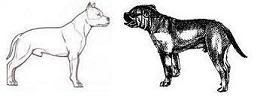
Amstaff & Ca de Bou
#110

Публикувано: 24 March 2008 - 03:49 AM
www.fci.be
FCI-Standard N° 249 / 13.06.1997 / GB
MALLORCA MASTIFF
(Perro Dogo Mallorquin, Ca de Bou)
TRANSLATION : C. Seidler.
ORIGIN : Spain.
DATE OF PUBLICATION OF THE ORIGINAL VALID STANDARD : 11.12.1996.
UTILIZATION : Watch and Guard Dog.
CLASSIFICATION F.C.I. : Group 2 Pinscher and Schnauzer-Molossoid breeds-Swiss Mountain Cattle Dogs and other breeds.
Section 2.1 Molossian, Mastiff type.
Without working trial.
BRIEF HISTORICAL SUMMARY : Since ancient times, seafaring from East to West in the Mediterranean region has led to the exchange of culture and science between nations. These reciprocal relations, even though mainly of a commercial nature, also gave the opportunity for an exchange of domestic animals. Amongst these were watch and guard dogs which were needed in harbours and coastal settlements as a protection against pirates and robbers coming in by sea. Amongst these mostly large, strong, resistant dogs with large heads and powerful teeth, one type distinguished itself. It was the mastiff of the Iberian Peninsula, which, in Spain, was used in various areas as a hunting or as a fighting dog against bulls and other dogs. This breed accompanied King Jacob 1 on his conquests and arrived in the Balearics about the year 1230. In the 17th century, Minorca and others areas came into British possession, following the treaty of Utrecht. The British brought their own fighting and guard dogs with them into the Balearics and crossed them with the native mastiffs of the Iberian Peninsula, which also occurred in the Balearic Isles. In the beginning of the 18th century, fights between dogs and bulls (bull baiting) were very popular and the Britons inhabiting the Island looked for a breed which would be held suited to such fights. These circumstances explain the name Ca de Bou, Bull Dog. In the Spanish Stud Book for the year 1923, the existence of this breed is already established.
The first official entry was in the year 1928 and in 1929, when such a breed was exhibited for the first time at a Dog Show in Barcelona.
GENERAL APPEARANCE : A typical Molossian of somewhat elongated build, strong and powerful, of medium size. The difference between the sexes is apparent in the head, whose circumference is definitely greater in dogs than in bitches.
BEHAVIOUR / TEMPERAMENT : Quiet by nature, he can under some circumstances be courageous and brave. He is at ease with people, faithful and devoted to his master. As a watch and guard dog, he is unsurpassed. In quiet situations, he is trusting and self assured. When roused, his expression is piercing.
HEAD : Strong and massive.
CRANIAL REGION :
Skull : Large, broad and almost square. Its circumference, specially in males, is greater than the chest measurement taken at the withers. Forehead is broad and flat. Frontal furrow well defined. Seen from the front, due to the shape of the skull, back of skull is not visible. Upper planes of skull and muzzle are almost parallel, lightly converging.
Stop : Seen from side, strongly defined and protruding; seen from front, only noticeable because the eyebrow arches form a definite frontal furrow.
FACIAL REGION : The jaw muscles are strong, protruding, well developed and reach to the middle region below the eye. Even though there are some folds which occur sideways over the chewing muscles, there are altogether no folds in the skin of the head.
Nose : Black and broad. The philtrum between the nostrils is well defined.
Muzzle : Set on at inner corner of eye, broad and conical, in profile reminiscent of a blunt cone with a broad base. The nasal bridge is staight, rising slightly. Length of muzzle is in proportion of 1 to 3 to length of skull.
Lips : Laterally the upper lip covers the lower lip to the middle part of the muzzle, where the corner of the mouth appears. The upper lip is rather taut, whereas the lower lip is folded in its middle part, so that in a closed muzzle, the lips are not noticeable. The completely red mucous membrane of the mouth cavity has distinct transversal ridges and the rims of the gums have black pigment.
Jaws/Teeth : The jaws are strong, incisors in a correct row and canines well apart. The mouth is complete, teeth white and strong. The bite is undershot; the gap of the not exaggerated undershot bite should not be more than 1 cm. When the muzzle is closed, teeth must not be visible.
Eyes : Large, oval in shape, lids wide open, clearly outlined and slightly slanting. Colour should be as dark as possible and according to coat colour. Conjunctiva not visible. Looked at from front, white of eyes should not be visible. The eyes are deep set and far apart.
Ears : Set on high and to the sides, rather small, with inner ear opening visible and drawn backwards in a curve; it is a so called rose ear. In repose, the tip of the ear is below the line of the eye.
NECK : Strong, thick, in harmony to the whole. At set on, roughly the diameter of the head; fitting well into withers. Skin slightly loose; thin dewlap permitted.
BODY :
Loins and flanks : Short, relatively narrow, with definite arch towards croup.
Croup : 1 to 2 cm higher in position than withers. Slanting to horizontal at an angle of 30 degrees and slightly narrower than chest.
Chest : The rib cage is somewhat cylindrical, deep and reaches to the elbows. As the tops of the shoulder blades are wide apart, the chest is broad at the height of the withers.
Lower line : The chest line runs parallel to the ground. The belly line rises and is tucked up lightly, not greyhound-like.
TAIL : Low set on. Thick at root, tapering towards the tip. Hangs naturally in repose; in action it forms a slight curve and is raised to height of the top line.
LIMBS
FOREQUARTERS :
Shoulders : Moderately short, slightly, slanting, hardly protruding.
Upper arm : Straight, parallel, set well apart.
Elbow : Standing away from the chest because of width of breast but in no way turned out.
Forearm : Well muscled, straight, strong bone structure.
Front feet : Strong with thick, close together, lightly rounded toes. Pads slightly pigmented.
HINDQUARTERS : Muscles broader than in forequarters.
Upper thigh : Broad, naturally angulated.
Hock : Short, straight, strong. Dewclaws not desired.
Hind feet : Strong with thick toes which are longer than those of front feet but altogether oval in shape. Pigmented pads preferred.
GAIT / MOVEMENT : The typical movement of this breed is the trot.
SKIN : Rather thick. Close fitting to body except on neck, where a slight dewlap may occur.
COAT
HAIR : Short and rough to the touch.
COLOUR : Brindle, fawn and black, preference in this order. In brindle dogs, dark tones are preferred, in fawn, the deeper shade is preferred. White patches are permitted on front feet, on chest and on muzzle up to a maximum of 30% of the whole coat. A black mask is also permitted.
SIZE AND WEIGHT :
Height at the withers : for dogs : from 55 to 58 cm.
for bitches : from 52 to 55 cm.
Weight : In dogs the weight ranges from 35 to 38 kg.
In bitches the weight ranges from 30 to 34 kg.
FAULTS : Any departure from the foregoing points should be considered a fault and the seriousness with which the fault should be regarded should be in exact proportion to its degree.
SERIOUS FAULTS :
Dogs which are taller at withers than their height at croup.
Undershot by more than 1 cm.
Scissor or pincer bite.
Lack of two premolars.
Lack of rose ears, ears which lie flat, close to cheeks. Ears set on erect, even if the back third is the shape of a rose ear.
Tail shaped like a Bulldogs.
Any other serious fault according to the standard.
DISQUALIFYING FAULTS :
Aggresive or overly shy.
Overshot mouth.
Light or yellow eyes.
Cropped ears or docked tail.
White colour which takes up more than 30% of the whole body elsewhere than on front legs, chest and muzzle.
Patches of any other colour.
MEASUREMENTS FOR A MEDIUM SIZE DOG :
Weight : 36 kg.
Height at croup : 58 cm.
Height at withers : 56 cm.
Chest circumference : 78 cm.
Head circumference : 59,5 cm.
Length from back skull
to set on of tail : 73 cm.
Length from back skull
to end of muzzle : 22 cm.
Length of muzzle to stop : 8 cm.
Any dog clearly showing physical or behavioural abnormalities shall be disqualified.
N.B. : Male animals should have two apparently normal testicles fully descended into the scrotum.

Argeadi & Bambi's Gentle Beasts

Amstaff & Ca de Bou
#111

Публикувано: 24 March 2008 - 04:09 AM
Имаме оште един мажјак и три женки ( едната че си остане км нас :blink:) остантите са слободни. Вижте ги 45 дни малките Ка де Бу.


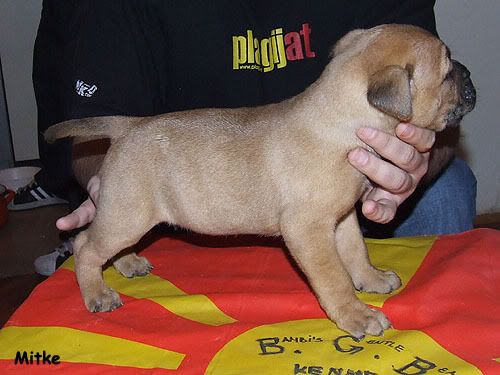
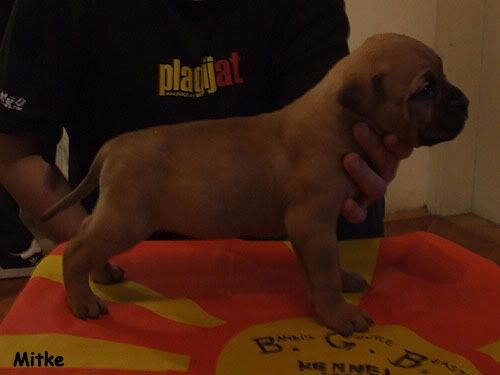
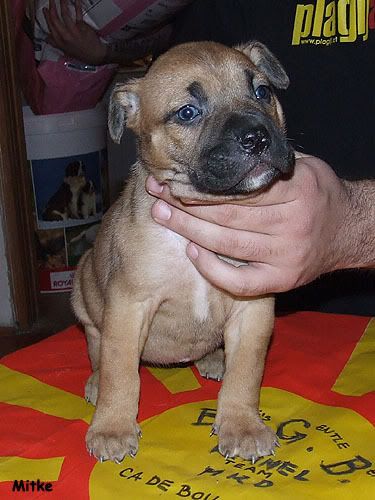
Bambi's Gentle Beasts kennel

Argeadi & Bambi's Gentle Beasts

Amstaff & Ca de Bou
#112

Публикувано: 24 March 2008 - 04:30 AM
Некои снимки от Данте
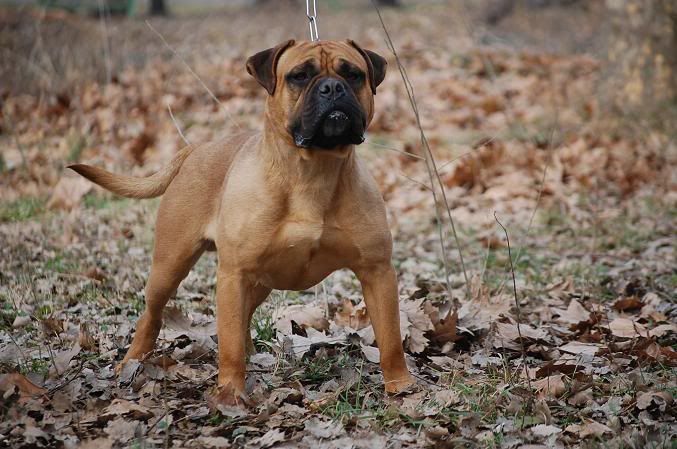


...вижте как малкиот Димитри ги обучава Данте и Маша :drugarche:

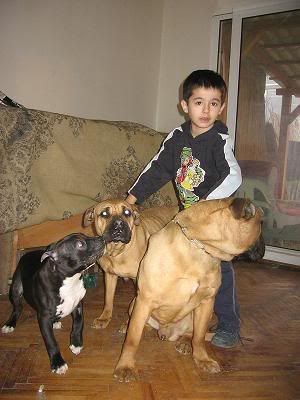
...оште малко снимки от Д легло от Bambi's Gentle Beasts kennel
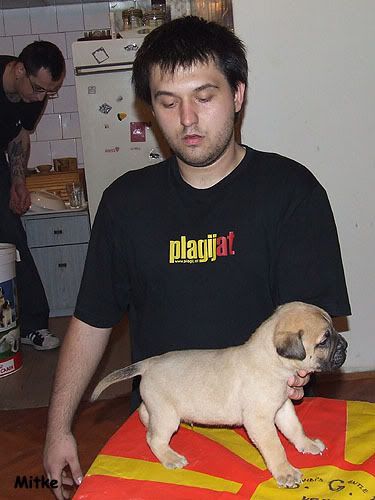
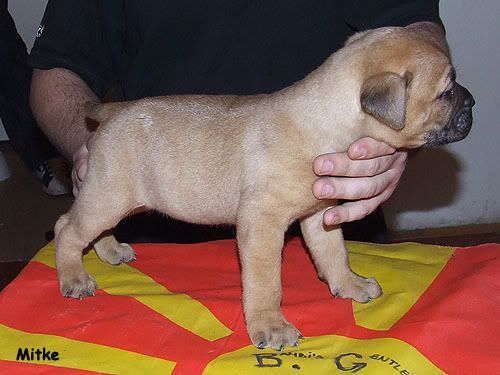
...това е един отличен примерок от Шабац, Србия казва се hu en la falcor
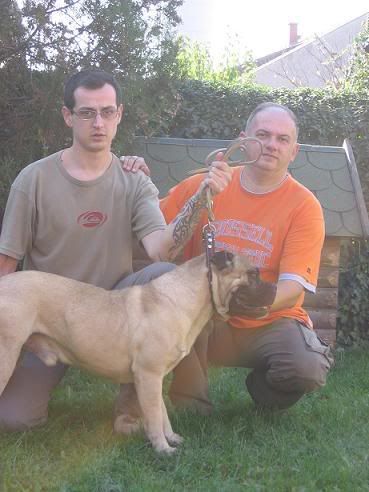

Argeadi & Bambi's Gentle Beasts

Amstaff & Ca de Bou
#113

Публикувано: 24 March 2008 - 04:56 AM
Цитат
Вижте този женка, тя е шампонка от Русия, между това сами отценете как е станала шампионка.
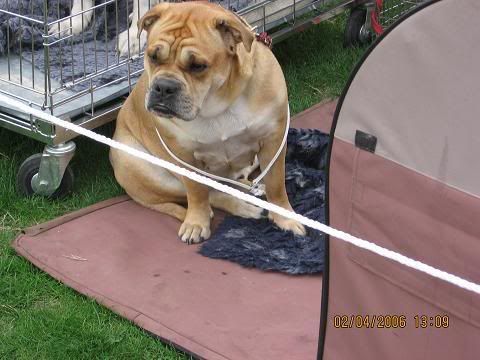
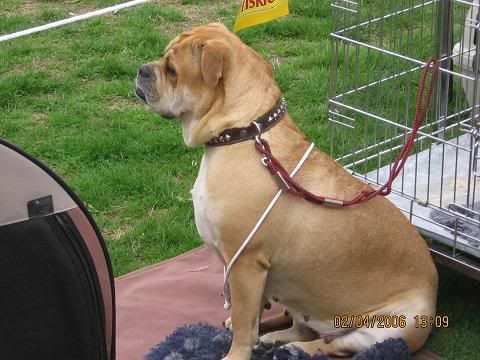
...никои пт не искам да отценавам други кучета, но имам горко искуство от изложби с Ка де Бу, кде некои судии не са запознаени и немат искуство с породата и могат да погрешат.
Поздравления от Bambi's Gentle Beasts kennel
Скопје, Македонија

Argeadi & Bambi's Gentle Beasts

Amstaff & Ca de Bou


 Вход
Вход Регистрация
Регистрация Помощ
Помощ



 Горе
Горе Цитиране +
Цитиране +



